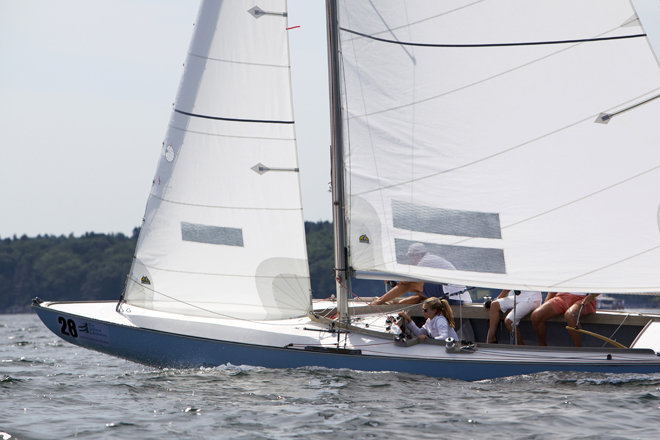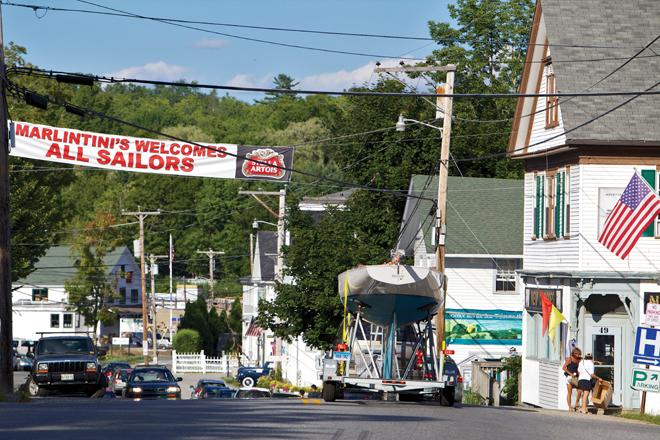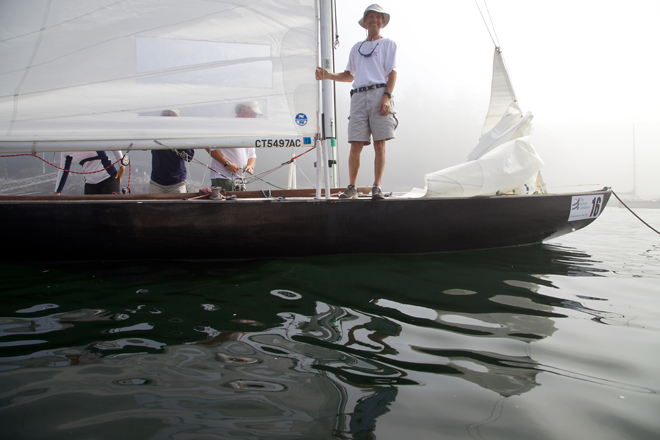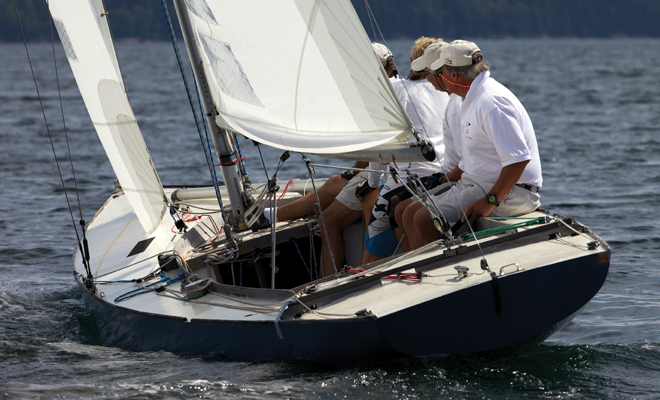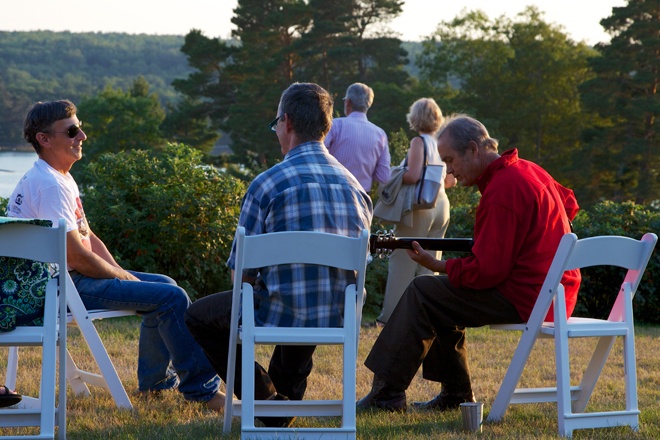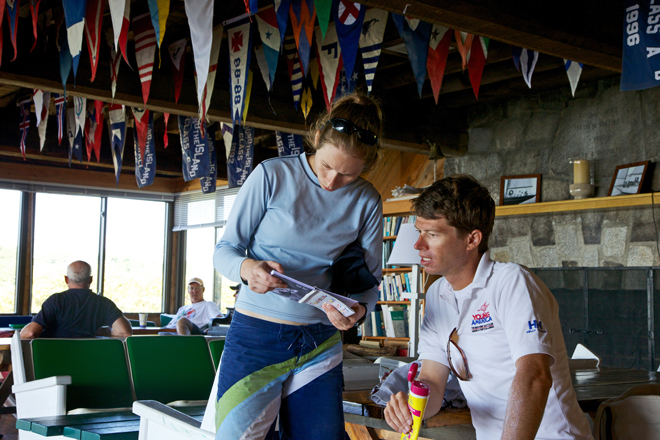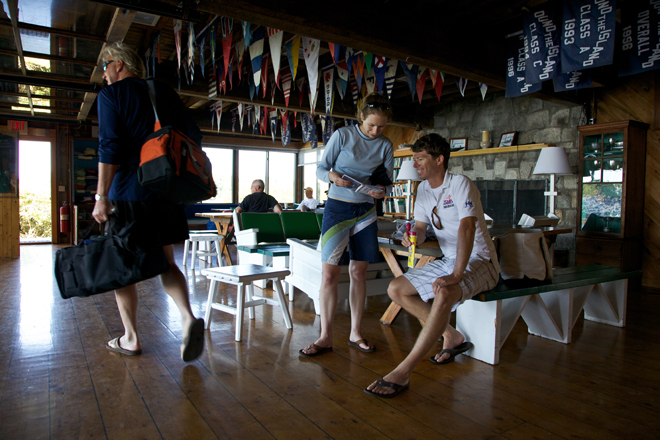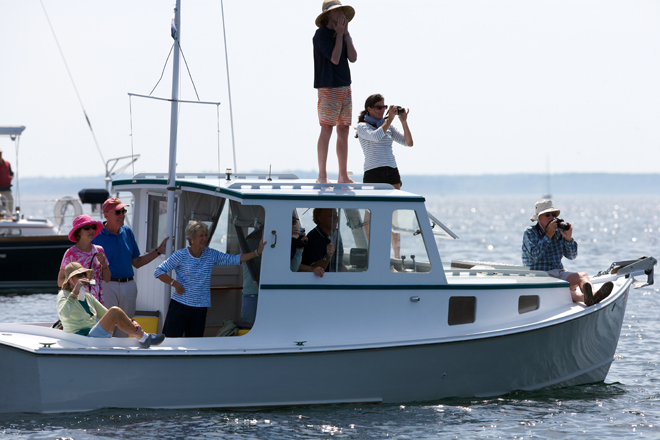Rum…Sailing…Rum…Maybe Dancing
FEATURE-July 2013
By Dennis Gilbert
Photography by Alison Langley
Camaraderie and Sport: the Atlantic Class Inaugurates a New Tradition on Blue Hill Bay
Race-day mornings are all about getting the boats out on the water. The residue of evening festivities recedes swiftly into the wake of the moment as crews board their craft and get down to work with rigging up. As bursts of static bring news of wind and weather over the VHF, all hands proceed with industry and rote efficiency. Meanwhile, gulls grounded by the morning fog and lobstermen motoring out to haul their traps regard the scene with an emphatic indifference.
A harbor start is a communal activity best described as shared oblivion: 41 crews are outfitting their sloops within an easy halloo of one another, yet all that matters to any of them is a microcosm of teak, Dacron, and brass contained inside their toe-rails. It is not until the boats are in motion that the world beyond the cockpit begins to materialize. A fleet this size tacking through a tight harbor generates its own kind of static: one vessel sliding too close off another’s bow is bound to raise a bit of pirate talk—intimations of the close-quarters skirmishing to come. Even before the vanguard has glided out from under the shroud of the cove and onto the sunny bay, the game has begun in earnest.
Today’s race is the fourth leg of the eighty-fourth annual Atlantic Nationals regatta, hosted by Kollegewidgwok Yacht Club of Blue Hill. Laid out this morning by race manager Ken Legler, the course is a standard “W” configuration comprising pairs of tacks and sprints, windward to leeward. Legler, a diviner of propitious conditions as they are about to arrive, is presently perched on the foredeck of the committee boat, reading the signs. Behind him 41 sloops are milling back and forth, scrimmaging for position. It is oddly quiet. But at any moment the first warning shot will drive this desultory displacement activity into a scramble of intense maneuvering: counting down the very same seconds ticking away on race manager’s watch, skippers will insinuate their vessels into that ideal convergence of momentum and placement from which to launch a swift, clean strike. Precisely on schedule, a blast of the starting gun will cleave the air, and a collective plunge of bows across the starting line will transform this flock of white chickens into a flight of fine seabirds.
The Atlantic Class sprang from the brow of W. Starling Burgess, a yacht and airplane builder whom historians, along with the sailors of his boats, regard as a figure much larger than life, in part for his role in designing three America’s Cup winners. His original racing design was an over-rigged sloop with a full lead keel balancing a surfeit of sail, a slippery day-racer destined from the start to acquire the status of a “classic.” Completing the plans in 1927, Burgess commissioned the German boatyard of Abeking and Rasmussen to build 99 hulls. His eye trained upon the thriving racing milieu of Long Island Sound, he shopped his prototype from club to club with enough success that, by 1929, the class was able to stage its first national championship, which was won by James Tillinghast aboard Taicoon out of Warwick, Rhode Island.
Prior to 1940, racing-class custom allowed only one boat per club to compete in the nationals. By 1932, ten were participating, but in 1939 the number dwindled to six. A rule change in 1940 made the regatta a free-for-all—open to any member of the class—and competition immediately stiffened to a field of 20. While the nationals has been hosted over the years by a total of 13 clubs, it currently cycles among just five: Cedar Point, Cold Spring Harbor, Madison Beach Club, and Niantic, all on Long Island Sound, and Maine’s Kollegewidgwok. Meanwhile, the fleet has grown back from its obscurity as pre-glass-hull curiosity to nearly its original wooden-boat-era strength, and participation in the nationals has become more consistently robust. Of the 41 entries racing last summer, 20 were trailered the 400 miles from Long Island Sound to Blue Hill Bay.
The Association Rules’ drawing of the Atlantic’s sail plan presents the profile of a toy boat a child might launch across a pond in a city park. Out on the open water, it cuts quite a different figure. Thirty feet in length and only six-and-a-half abeam, carrying over 375 square feet of sail, this sloop is as taut and sleek as a bluefin. She livens up in the most moderate wind, sails very fast, and races at her peak between 10 and 15 knots. Converged for a national championship and crewed by sailors who have, literally, a collective experience in the centuries, the Atlantic excels as both sport and spectacle. The buoy-marked “W” configurations of the day courses, for example, capture all the excitement of a close-fought relay race, where every leg is a dash to exhaustion and every turn generates a fresh burst of energy.
But quite another Atlantic emerged from the inaugural W. Starling Burgess Cup race, a ten-nautical-mile circumnavigation of Long Island (Blue Hill’s own) that ran on the afternoon of August 23 last year. Unconstrained by gates and pins, taut sails spreading out across the full reach of the bay, the fleet struck an iconic image of America in her day-sailing prime: there may be no more amiable communion with Nature than rolling around a bay in the lap of a companionable wind, but the fight up this long course to the turning mark evoked a sense of the restless human spirit contending with a refractory physical world.
As the field made its turn and let the spinnakers fly, the eastern arm of the bay became a broad allée of bright pastel balloons streaming on for half a league. By now, early momentum had carried the leaders farther and farther ahead, down the leeward leg; the finish was turning into a three-way sprint, and the flotilla of spectators gathered round the committee boat was cheered to see Ben Wells’s Questra, out of KYC, in the lead. Then Norm Peck’s Miss April fell away, and Steve Benjamin’s Cassidy made its move and soon was nosing up, nosing up…
“…rum…sailing…rum…dinner…maybe dancing…” This droll summation of regatta ethos is the coinage of Isla Miller, foredeck of Sangria and a principal organizer of this remarkable week of camaraderie and sport, a standout in class history. With Terry Britton chairing the planning committee from his home in Boulder, Colorado, Miller became the on-site activator of everything from signing the dozen or so sponsors to coordinating events at the John Peters Estate, a gentlemanly residence of brick, barn board, and hayfield crowning the overlook between the village landing and the yacht club dock. From the outset, the planners grasped the significance of this venue to the success of the regatta, not only because of its proximity and elegance but also because ambitious promotion of events promised to swell participation beyond the capacity of the clubhouse down on the shore. Here, across spacious lawns and under expansive pavilions, as many as 300 sailors, spectators, sponsors, and guests joined nightly in the post-race festivities. The publication of race results merging with the social hour, competitive streak surrendering to gregarious impulse, revelers hailed the day’s winners, toasted the health and happiness of the class, shared the sumptuous board…and yes, there was dancing.
Here, too, skipper Steve Benjamin of Seawanhaka Corinthian was presented the first ever Burgess Cup, the very same silver bowl engraved in 1929 with the name of James Tillinghast. Rescued from its long sleep in a far corner of the past, it had been burnished back to life to mark the inauguration of a new tradition of the Atlantic Class.
Unlike most physically demanding sports, sailboat racing is not strictly the province of the young. A glance at Atlantic Nationals results reveals that, between them, Norm Peck, Jr. of Niantic—now 83 years old—and his contemporary from Cedar Point, George Reichhelm, have captured 28 titles in the last 40 years. Peck won as recently as 2010; Reichhelm, 2008. Clearly, the sport favors those skippers who know their boats best—the 2012 winner, Norm Peck III, first sailed Nonesuch to victory in 1981—and those crews who have been sailing together the longest—Steve Benjamin credits his crew of 15 years with the Burgess Cup win. While these indicators underscore the value of experience in a sport that requires stamina, ingenuity and seasoned intuition, they also suggest a secondary inference: that the current Atlantic Class comprises a graying fleet poised on the threshold of an intergenerational lull.
Fit and fiftyish, the second-youngest member of the KYC board, Terry Britton concedes that his club may be in “one of those cycles where the baton is being handed off [and] it’s time to groom the next group to take over.” But he also cites the numbers—41 entries in 2012 tied a record set in 1947—as proof of the health of the class. “The class at times has been as low as five boats racing, and now it’s stronger than ever…by far…and it’s at a time when other clubs are struggling and sailing is diminishing.”
One reason KYC, and last year’s regatta, are emblematic of a thriving one-design culture is because of the club’s vibrant volunteer spirit, epitomized by Britton, Miller, Andrew Baldwin, and others. It has also fused sustainability with strategic collaborations outside the class. The “buy local” spirit of the 2012 regatta brought the resources of Maine-based sponsors and the services of local artists and enterprises into a regional convergence. The club’s partnership with the Blue Hill Peninsula Chamber of Commerce, which it joined in 2011, enhanced the participation of local businesses and introduced scores of people from outside the class and club to the fellowship. Perhaps the most effective force behind KYC’s continued vitality is KSEA, the club’s sailing school. From the last week in June up to the middle of August each year, KSEA matches seven seasoned instructors with over 200 kids. Lessons range from beginner level to an advanced 420-racing team that competes in local regattas. Last year, the club introduced an innovation in outreach, Community Sailing Week. In the week prior to the official term, lessons are made available free of charge to anyone in the area who wants to learn how to sail. Britton acknowledges a marriage of generosity and self-interest here, “the desire to turn people on to [sailing] and get them involved.”
“I may own the boat,” he says, “but I need three other people to help me sail it.”
In 2008, nearly eight decades after Tillinghast sailed to the first championship, Kollegewidgwok hosted its first nationals. Thirty-five sloops were entered, a total surpassed only a half-dozen times in class history. The record attendance at last year’s regatta, the challenges and thrills of sailing Blue Hill Bay, the picturesque and lavish welcome, and the inauguration of the Burgess Cup race, have established KYC as a new source of vitality for the class. While Atlantic aficionados are looking forward to the Madison nationals in 2013, they’re already talking about returning to Blue Hill.







